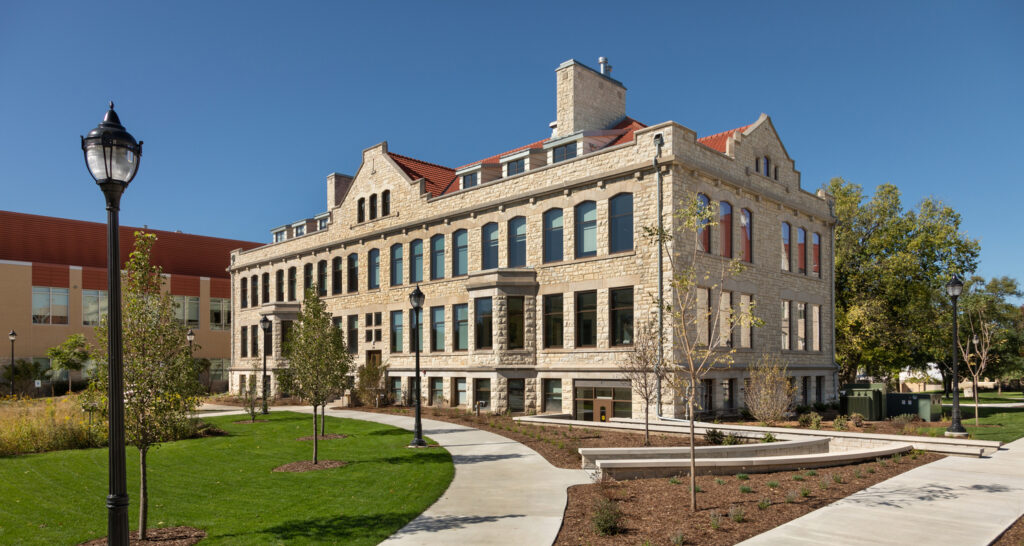The built environment is accountable for a substantial 40% of annual global greenhouse gas (GHG) emissions. These GHG emissions are commonly referred to as operational carbon and embodied carbon. While operational carbon is generated after a building is constructed due to the energy a building consumes, embodied carbon is a result of the construction process itself. The extraction, manufacturing, transportation, and construction of building materials all layer into the embodied carbon of a project.
It’s imperative that designers find solutions to reduce embodied and operational carbon emissions of the built environment. Carl Elefante, former AIA president, is known for coining the phrase, “The greenest building… is one that’s already built.” Adaptive reuse, the transformation of existing facilities for a new use, is one way we integrate Elefante’s message into our designs. Valuing, restoring, and updating historic buildings like Rankin Hall at Carroll University, is another.
Maintaining a Legacy
Listed on the National Register of Historical Places, Rankin Hall was built in 1906 in the heart of Carroll University’s campus, housing science labs and classrooms. High-quality details showed the care and craft that went into the historic construction typical of the 1900s era, like the exterior limestone façade backed with brick, internal plaster, operable single-hung windows, clay tile roof, wood doors with glass transoms, wood floors and wainscoting, and skylights.
The impressive features utilized passive design strategies that were available before the technology we have today. Tall, operable windows were used to allow daylight and air to flow into the building, and tall chimneys provided a way to circulate warm air to keep occupants comfortable in the cold climate. The masonry walls provided some thermal delay and served as a vapor permeable water barrier to keep out the rain.
Almost 50 years had gone by since the last major renovation of Rankin Hall in 1975. Although the remarkable quality of the structure remained, BWBR was brought in to modernize Rankin Hall to meet the next generation’s needs while respecting the character, dignity, and history of the original construction.
Reduce, Reuse, Restore
When BWBR took on the renovation in 2018, the design team found the historic construction provided a valuable platform from which to start. Despite its age, the limestone exterior was in great condition, allowing it to remain untouched aside from gentle cleaning and repairing the mortar. In a diligent process, the original wood windows throughout the facility were removed for restoration before being returned to their previous home. Along with this, the team carefully restored the original wood flooring hidden under layers of carpet and tile, while the door, window, and wall trim were salvaged and reused. Where possible, the existing wood and plaster walls were retained and repaired.
The team then layered in high quality materials and energy-saving systems. To improve the thermal performance of the exterior shell, insulated ultra-clear glass was added outside of the historic wood windows, and insulation was added to the attic space, roof rafters, and foundation walls. Light fixtures were upgraded to high-quality, low-energy LED fixtures, and the mechanical systems were updated to both maximize efficiency and provide metering, allowing the building’s energy usage to be tracked separately from the campus’ district system.
The Next 100 Years
Along with these achievements, the designers brought the 100+ year old facility up to modern accessibility standards, creating its first-ever accessible entrance, installing an elevator, and adding all-gender restrooms. By approaching the project holistically, with an eye toward both equity and sustainability, the team was able to create a welcoming environment for everyone who enters while maintaining its historic character.
The hall now houses nine classrooms and labs with integrated technology, 25 faculty offices, and a variety of study spaces. The renovation improved functionality and comfort for students of the present, and will continue to do so for decades to come while serving as a model of responsible resource stewardship.
Rankin Hall’s renovation achieved a 37% indoor water-use reduction, 13% energy cost savings, as well as LEEDv4 BD+C Major Renovation certification. The project also received the George Gunn Award for Excellence in Architectural Preservation and Historic Restoration.








